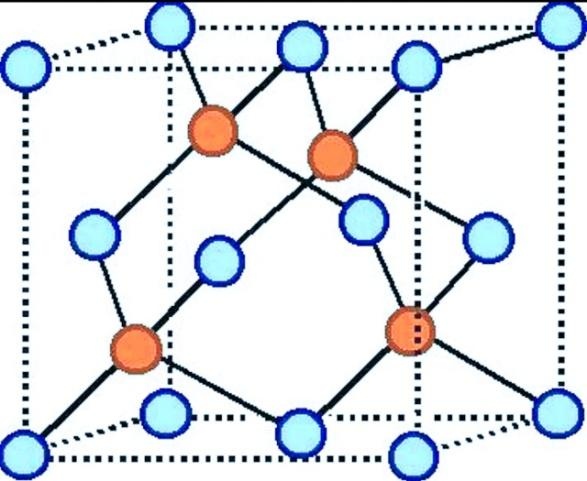
Statement: In the ZnS (zinc blend) structure, the coordination number of each ion is 4.
State whether the given statement is true or false.
Answer
139.8k+ views
Hint: Zinc blend is also known as Sphalerite. It has a face-centered cubic structure. Each atom in the zinc blende or Sphalerite is surrounded by 4 atoms. ZnS also occurs in the Wurtzite form.
Complete step by step answer:
There are two common forms of ZnS. These are zinc blend, also known as Sphalerite and Wurtzite form.
Both of them have some common features:
i)- Both of them have a stoichiometry of 1:1 of Zn: S.
ii)- Each ion in both structures is surrounded by 4 atoms. They have coordination number 4.
iii)- Both of them have tetrahedral coordination.
The structure of the zinc blende (Sphalerite) is based on a face-centered cubic structure whereas the structure of Wurtzite is hexagonal cubic centered.
In both the structures there are 2 types of tetrahedral holes, in which half of them are occupied by the cations.
In both structures the bonding to the nearest neighbor atom is similar but with farther atoms the distance and bond angles are different.
There are 4 asymmetric units in zinc blende and 2 asymmetric units in Wurtzite.
Zinc blend has its own antitype i.e. both the cations and anions can switch their places and it does not affect the shape of the structure.
Hence it is a 4 coordinate ion and has a tetrahedral geometry.
The structure of the zinc blende is given below:

Where blue circles represent the sulfur ions and orange circles represent the zinc ions.
Hence, the statement ZnS (zinc blend) structure, the coordination number of each ion is 4 is true.
Note: The cations and anions can switch their places in the structure of zinc blend the same as in the structure of NaCl. In the zinc blende structure, if we replace all the zinc and sulfur ions with carbon atoms we get the same structure of diamond.
Complete step by step answer:
There are two common forms of ZnS. These are zinc blend, also known as Sphalerite and Wurtzite form.
Both of them have some common features:
i)- Both of them have a stoichiometry of 1:1 of Zn: S.
ii)- Each ion in both structures is surrounded by 4 atoms. They have coordination number 4.
iii)- Both of them have tetrahedral coordination.
The structure of the zinc blende (Sphalerite) is based on a face-centered cubic structure whereas the structure of Wurtzite is hexagonal cubic centered.
In both the structures there are 2 types of tetrahedral holes, in which half of them are occupied by the cations.
In both structures the bonding to the nearest neighbor atom is similar but with farther atoms the distance and bond angles are different.
There are 4 asymmetric units in zinc blende and 2 asymmetric units in Wurtzite.
Zinc blend has its own antitype i.e. both the cations and anions can switch their places and it does not affect the shape of the structure.
Hence it is a 4 coordinate ion and has a tetrahedral geometry.
The structure of the zinc blende is given below:

Where blue circles represent the sulfur ions and orange circles represent the zinc ions.
Hence, the statement ZnS (zinc blend) structure, the coordination number of each ion is 4 is true.
Note: The cations and anions can switch their places in the structure of zinc blend the same as in the structure of NaCl. In the zinc blende structure, if we replace all the zinc and sulfur ions with carbon atoms we get the same structure of diamond.
Latest Vedantu courses for you
Grade 10 | MAHARASHTRABOARD | SCHOOL | English
Vedantu 10 Maharashtra Pro Lite (2025-26)
School Full course for MAHARASHTRABOARD students
₹31,500 per year
EMI starts from ₹2,625 per month
Recently Updated Pages
Average fee range for JEE coaching in India- Complete Details

Difference Between Rows and Columns: JEE Main 2024

Difference Between Length and Height: JEE Main 2024

Difference Between Natural and Whole Numbers: JEE Main 2024

Algebraic Formula

Difference Between Constants and Variables: JEE Main 2024

Trending doubts
JEE Main 2025 Session 2: Application Form (Out), Exam Dates (Released), Eligibility, & More

JEE Main 2025: Derivation of Equation of Trajectory in Physics

Learn About Angle Of Deviation In Prism: JEE Main Physics 2025

Number of sigma and pi bonds in C2 molecule isare A class 11 chemistry JEE_Main

Electric Field Due to Uniformly Charged Ring for JEE Main 2025 - Formula and Derivation

JEE Main 2025: Conversion of Galvanometer Into Ammeter And Voltmeter in Physics

Other Pages
NCERT Solutions for Class 11 Chemistry Chapter 9 Hydrocarbons

NCERT Solutions for Class 11 Chemistry Chapter 7 Redox Reaction

JEE Advanced Marks vs Ranks 2025: Understanding Category-wise Qualifying Marks and Previous Year Cut-offs

NCERT Solutions for Class 11 Chemistry Chapter 5 Thermodynamics

Hydrocarbons Class 11 Notes: CBSE Chemistry Chapter 9

NCERT Solutions for Class 11 Chemistry In Hindi Chapter 1 Some Basic Concepts of Chemistry




